Hao Dai
Continual Generalized Category Discovery: Learning and Forgetting from a Bayesian Perspective
Jul 23, 2025Abstract:Continual Generalized Category Discovery (C-GCD) faces a critical challenge: incrementally learning new classes from unlabeled data streams while preserving knowledge of old classes. Existing methods struggle with catastrophic forgetting, especially when unlabeled data mixes known and novel categories. We address this by analyzing C-GCD's forgetting dynamics through a Bayesian lens, revealing that covariance misalignment between old and new classes drives performance degradation. Building on this insight, we propose Variational Bayes C-GCD (VB-CGCD), a novel framework that integrates variational inference with covariance-aware nearest-class-mean classification. VB-CGCD adaptively aligns class distributions while suppressing pseudo-label noise via stochastic variational updates. Experiments show VB-CGCD surpasses prior art by +15.21% with the overall accuracy in the final session on standard benchmarks. We also introduce a new challenging benchmark with only 10% labeled data and extended online phases, VB-CGCD achieves a 67.86% final accuracy, significantly higher than state-of-the-art (38.55%), demonstrating its robust applicability across diverse scenarios. Code is available at: https://github.com/daihao42/VB-CGCD
ViRN: Variational Inference and Distribution Trilateration for Long-Tailed Continual Representation Learning
Jul 23, 2025Abstract:Continual learning (CL) with long-tailed data distributions remains a critical challenge for real-world AI systems, where models must sequentially adapt to new classes while retaining knowledge of old ones, despite severe class imbalance. Existing methods struggle to balance stability and plasticity, often collapsing under extreme sample scarcity. To address this, we propose ViRN, a novel CL framework that integrates variational inference (VI) with distributional trilateration for robust long-tailed learning. First, we model class-conditional distributions via a Variational Autoencoder to mitigate bias toward head classes. Second, we reconstruct tail-class distributions via Wasserstein distance-based neighborhood retrieval and geometric fusion, enabling sample-efficient alignment of tail-class representations. Evaluated on six long-tailed classification benchmarks, including speech (e.g., rare acoustic events, accents) and image tasks, ViRN achieves a 10.24% average accuracy gain over state-of-the-art methods.
Ring-lite: Scalable Reasoning via C3PO-Stabilized Reinforcement Learning for LLMs
Jun 18, 2025Abstract:We present Ring-lite, a Mixture-of-Experts (MoE)-based large language model optimized via reinforcement learning (RL) to achieve efficient and robust reasoning capabilities. Built upon the publicly available Ling-lite model, a 16.8 billion parameter model with 2.75 billion activated parameters, our approach matches the performance of state-of-the-art (SOTA) small-scale reasoning models on challenging benchmarks (e.g., AIME, LiveCodeBench, GPQA-Diamond) while activating only one-third of the parameters required by comparable models. To accomplish this, we introduce a joint training pipeline integrating distillation with RL, revealing undocumented challenges in MoE RL training. First, we identify optimization instability during RL training, and we propose Constrained Contextual Computation Policy Optimization(C3PO), a novel approach that enhances training stability and improves computational throughput via algorithm-system co-design methodology. Second, we empirically demonstrate that selecting distillation checkpoints based on entropy loss for RL training, rather than validation metrics, yields superior performance-efficiency trade-offs in subsequent RL training. Finally, we develop a two-stage training paradigm to harmonize multi-domain data integration, addressing domain conflicts that arise in training with mixed dataset. We will release the model, dataset, and code.
CAAP: Class-Dependent Automatic Data Augmentation Based On Adaptive Policies For Time Series
Apr 01, 2024
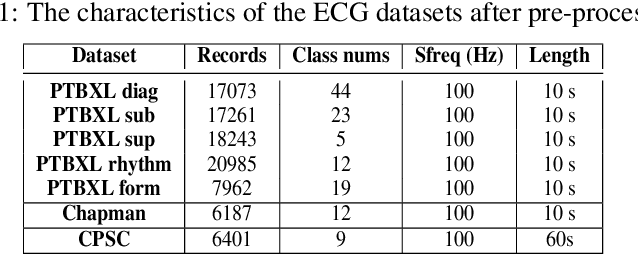
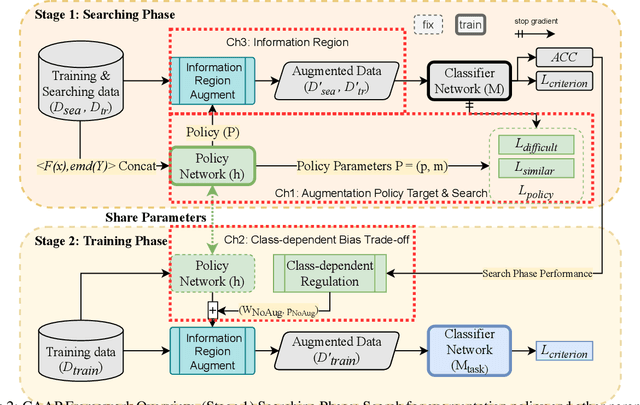

Abstract:Data Augmentation is a common technique used to enhance the performance of deep learning models by expanding the training dataset. Automatic Data Augmentation (ADA) methods are getting popular because of their capacity to generate policies for various datasets. However, existing ADA methods primarily focused on overall performance improvement, neglecting the problem of class-dependent bias that leads to performance reduction in specific classes. This bias poses significant challenges when deploying models in real-world applications. Furthermore, ADA for time series remains an underexplored domain, highlighting the need for advancements in this field. In particular, applying ADA techniques to vital signals like an electrocardiogram (ECG) is a compelling example due to its potential in medical domains such as heart disease diagnostics. We propose a novel deep learning-based approach called Class-dependent Automatic Adaptive Policies (CAAP) framework to overcome the notable class-dependent bias problem while maintaining the overall improvement in time-series data augmentation. Specifically, we utilize the policy network to generate effective sample-wise policies with balanced difficulty through class and feature information extraction. Second, we design the augmentation probability regulation method to minimize class-dependent bias. Third, we introduce the information region concepts into the ADA framework to preserve essential regions in the sample. Through a series of experiments on real-world ECG datasets, we demonstrate that CAAP outperforms representative methods in achieving lower class-dependent bias combined with superior overall performance. These results highlight the reliability of CAAP as a promising ADA method for time series modeling that fits for the demands of real-world applications.
Open Set Dandelion Network for IoT Intrusion Detection
Nov 19, 2023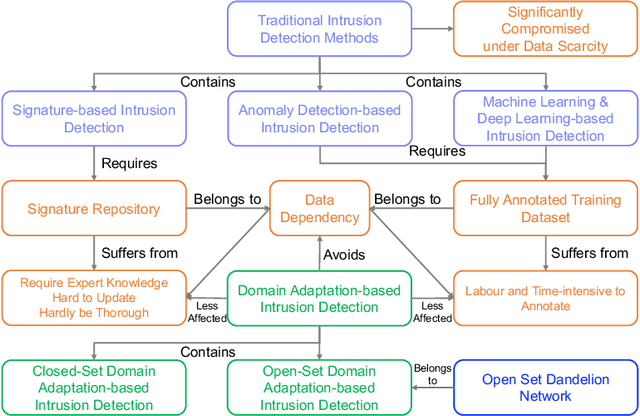
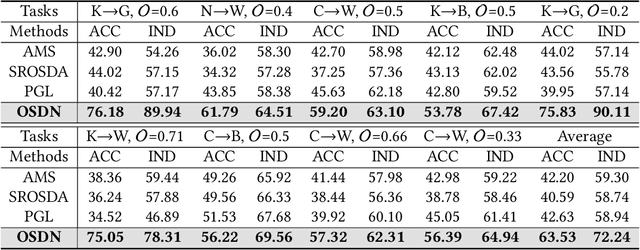
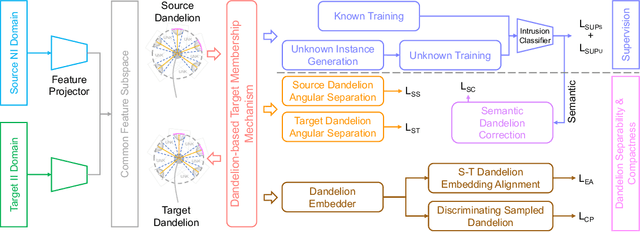
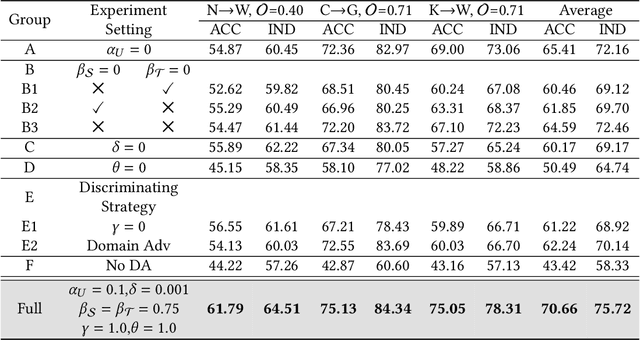
Abstract:As IoT devices become widely, it is crucial to protect them from malicious intrusions. However, the data scarcity of IoT limits the applicability of traditional intrusion detection methods, which are highly data-dependent. To address this, in this paper we propose the Open-Set Dandelion Network (OSDN) based on unsupervised heterogeneous domain adaptation in an open-set manner. The OSDN model performs intrusion knowledge transfer from the knowledge-rich source network intrusion domain to facilitate more accurate intrusion detection for the data-scarce target IoT intrusion domain. Under the open-set setting, it can also detect newly-emerged target domain intrusions that are not observed in the source domain. To achieve this, the OSDN model forms the source domain into a dandelion-like feature space in which each intrusion category is compactly grouped and different intrusion categories are separated, i.e., simultaneously emphasising inter-category separability and intra-category compactness. The dandelion-based target membership mechanism then forms the target dandelion. Then, the dandelion angular separation mechanism achieves better inter-category separability, and the dandelion embedding alignment mechanism further aligns both dandelions in a finer manner. To promote intra-category compactness, the discriminating sampled dandelion mechanism is used. Assisted by the intrusion classifier trained using both known and generated unknown intrusion knowledge, a semantic dandelion correction mechanism emphasises easily-confused categories and guides better inter-category separability. Holistically, these mechanisms form the OSDN model that effectively performs intrusion knowledge transfer to benefit IoT intrusion detection. Comprehensive experiments on several intrusion datasets verify the effectiveness of the OSDN model, outperforming three state-of-the-art baseline methods by 16.9%.
Adaptive Bi-Recommendation and Self-Improving Network for Heterogeneous Domain Adaptation-Assisted IoT Intrusion Detection
Mar 25, 2023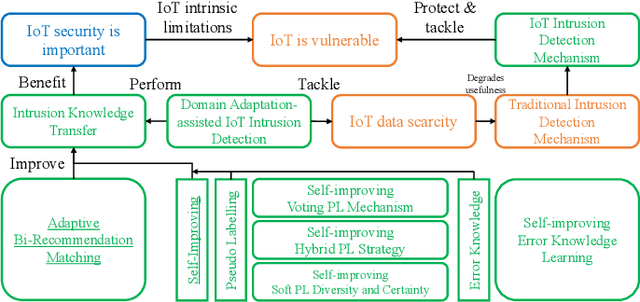
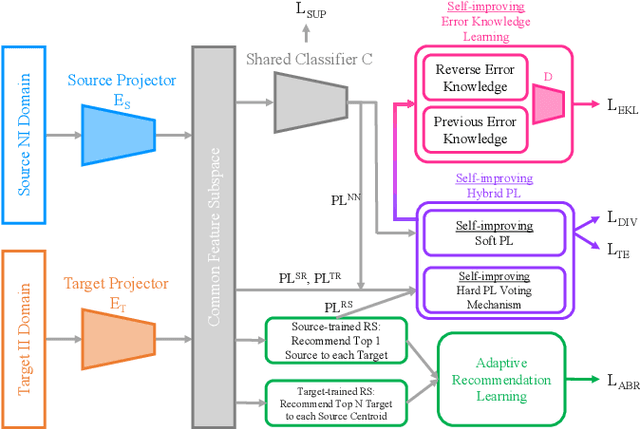
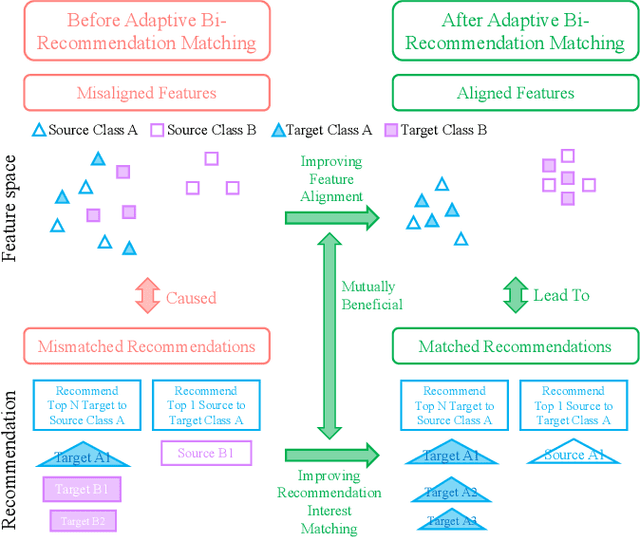

Abstract:As Internet of Things devices become prevalent, using intrusion detection to protect IoT from malicious intrusions is of vital importance. However, the data scarcity of IoT hinders the effectiveness of traditional intrusion detection methods. To tackle this issue, in this paper, we propose the Adaptive Bi-Recommendation and Self-Improving Network (ABRSI) based on unsupervised heterogeneous domain adaptation (HDA). The ABRSI transfers enrich intrusion knowledge from a data-rich network intrusion source domain to facilitate effective intrusion detection for data-scarce IoT target domains. The ABRSI achieves fine-grained intrusion knowledge transfer via adaptive bi-recommendation matching. Matching the bi-recommendation interests of two recommender systems and the alignment of intrusion categories in the shared feature space form a mutual-benefit loop. Besides, the ABRSI uses a self-improving mechanism, autonomously improving the intrusion knowledge transfer from four ways. A hard pseudo label voting mechanism jointly considers recommender system decision and label relationship information to promote more accurate hard pseudo label assignment. To promote diversity and target data participation during intrusion knowledge transfer, target instances failing to be assigned with a hard pseudo label will be assigned with a probabilistic soft pseudo label, forming a hybrid pseudo-labelling strategy. Meanwhile, the ABRSI also makes soft pseudo-labels globally diverse and individually certain. Finally, an error knowledge learning mechanism is utilised to adversarially exploit factors that causes detection ambiguity and learns through both current and previous error knowledge, preventing error knowledge forgetfulness. Holistically, these mechanisms form the ABRSI model that boosts IoT intrusion detection accuracy via HDA-assisted intrusion knowledge transfer.
Heterogeneous Domain Adaptation for IoT Intrusion Detection: A Geometric Graph Alignment Approach
Jan 24, 2023Abstract:Data scarcity hinders the usability of data-dependent algorithms when tackling IoT intrusion detection (IID). To address this, we utilise the data rich network intrusion detection (NID) domain to facilitate more accurate intrusion detection for IID domains. In this paper, a Geometric Graph Alignment (GGA) approach is leveraged to mask the geometric heterogeneities between domains for better intrusion knowledge transfer. Specifically, each intrusion domain is formulated as a graph where vertices and edges represent intrusion categories and category-wise interrelationships, respectively. The overall shape is preserved via a confused discriminator incapable to identify adjacency matrices between different intrusion domain graphs. A rotation avoidance mechanism and a centre point matching mechanism is used to avoid graph misalignment due to rotation and symmetry, respectively. Besides, category-wise semantic knowledge is transferred to act as vertex-level alignment. To exploit the target data, a pseudo-label election mechanism that jointly considers network prediction, geometric property and neighbourhood information is used to produce fine-grained pseudo-label assignment. Upon aligning the intrusion graphs geometrically from different granularities, the transferred intrusion knowledge can boost IID performance. Comprehensive experiments on several intrusion datasets demonstrate state-of-the-art performance of the GGA approach and validate the usefulness of GGA constituting components.
Multi-Scenario Bimetric-Balanced IoT Resource Allocation: An Evolutionary Approach
Nov 10, 2022Abstract:In this paper, we allocate IoT devices as resources for smart services with time-constrained resource requirements. The allocation method named as BRAD can work under multiple resource scenarios with diverse resource richnesses, availabilities and costs, such as the intelligent healthcare system deployed by Harbin Institute of Technology (HIT-IHC). The allocation aims for bimetric-balancing under the multi-scenario case, i.e., the profit and cost associated with service satisfaction are jointly optimised and balanced wisely. Besides, we abstract IoT devices as digital objects (DO) to make them easier to interact with during resource allocation. Considering that the problem is NP-Hard and the optimisation objective is not differentiable, we utilise Grey Wolf Optimisation (GWO) algorithm as the model optimiser. Specifically, we tackle the deficiencies of GWO and significantly improve its performance by introducing three new mechanisms to form the BRAD-GWA algorithm. Comprehensive experiments are conducted on realistic HIT-IHC IoT testbeds and several algorithms are compared, including the allocation method originally used by HIT-IHC system to verify the effectiveness of the BRAD-GWA. The BRAD-GWA achieves a 3.14 times and 29.6% objective reduction compared with the HIT-IHC and the original GWO algorithm, respectively.
Joint Semantic Transfer Network for IoT Intrusion Detection
Oct 28, 2022Abstract:In this paper, we propose a Joint Semantic Transfer Network (JSTN) towards effective intrusion detection for large-scale scarcely labelled IoT domain. As a multi-source heterogeneous domain adaptation (MS-HDA) method, the JSTN integrates a knowledge rich network intrusion (NI) domain and another small-scale IoT intrusion (II) domain as source domains, and preserves intrinsic semantic properties to assist target II domain intrusion detection. The JSTN jointly transfers the following three semantics to learn a domain-invariant and discriminative feature representation. The scenario semantic endows source NI and II domain with characteristics from each other to ease the knowledge transfer process via a confused domain discriminator and categorical distribution knowledge preservation. It also reduces the source-target discrepancy to make the shared feature space domain-invariant. Meanwhile, the weighted implicit semantic transfer boosts discriminability via a fine-grained knowledge preservation, which transfers the source categorical distribution to the target domain. The source-target divergence guides the importance weighting during knowledge preservation to reflect the degree of knowledge learning. Additionally, the hierarchical explicit semantic alignment performs centroid-level and representative-level alignment with the help of a geometric similarity-aware pseudo-label refiner, which exploits the value of unlabelled target II domain and explicitly aligns feature representations from a global and local perspective in a concentrated manner. Comprehensive experiments on various tasks verify the superiority of the JSTN against state-of-the-art comparing methods, on average a 10.3% of accuracy boost is achieved. The statistical soundness of each constituting component and the computational efficiency are also verified.
PECCO: A Profit and Cost-oriented Computation Offloading Scheme in Edge-Cloud Environment with Improved Moth-flame Optimisation
Aug 09, 2022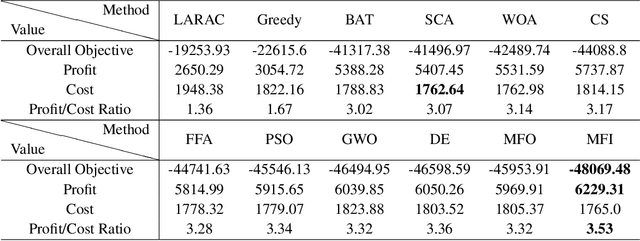
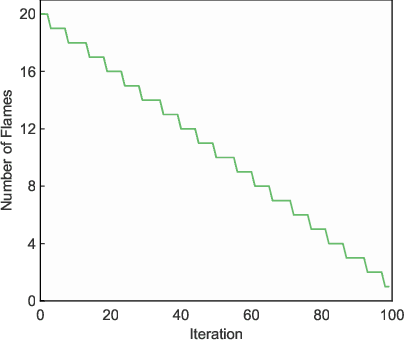
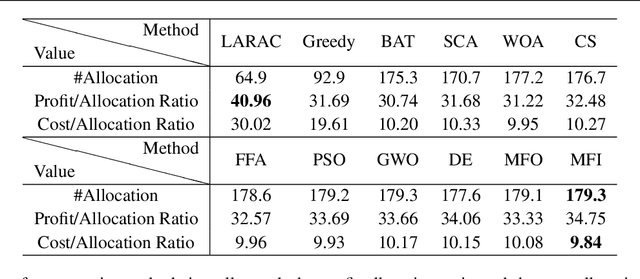

Abstract:With the fast growing quantity of data generated by smart devices and the exponential surge of processing demand in the Internet of Things (IoT) era, the resource-rich cloud centres have been utilised to tackle these challenges. To relieve the burden on cloud centres, edge-cloud computation offloading becomes a promising solution since shortening the proximity between the data source and the computation by offloading computation tasks from the cloud to edge devices can improve performance and Quality of Service (QoS). Several optimisation models of edge-cloud computation offloading have been proposed that take computation costs and heterogeneous communication costs into account. However, several important factors are not jointly considered, such as heterogeneities of tasks, load balancing among nodes and the profit yielded by computation tasks, which lead to the profit and cost-oriented computation offloading optimisation model PECCO proposed in this paper. Considering that the model is hard in nature and the optimisation objective is not differentiable, we propose an improved Moth-flame optimiser PECCO-MFI which addresses some deficiencies of the original Moth-flame Optimiser and integrate it under the edge-cloud environment. Comprehensive experiments are conducted to verify the superior performance of the proposed method when optimising the proposed task offloading model under the edge-cloud environment.
 Add to Chrome
Add to Chrome Add to Firefox
Add to Firefox Add to Edge
Add to Edge